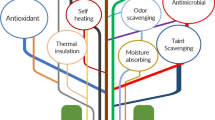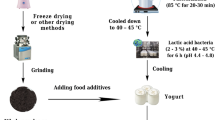Abstract
Yoghurt is one of the health-functional foods and its nutritive value can be enhanced by adding native fruit. This study aimed to produce novel functional probiotic yoghurt using Bifidobacterium longum (B. longum) strain and White sapote fruits pulp (WSP) at levels of 5, 10, and 15%. WSP contains 19.87% carbohydrates, 0.90% protein, 0.35% fat, 0.78% fiber, 0.6% ash, 48.70 (mg GAE/100 g) total phenolic, 28.25 (mg/100 g) ascorbic acid and 153.53 (IC50 (mg/mL)) for antioxidant activity. Physicochemical, microbiological and sensory evaluation of flavored yoghurt samples were investigated during storage at 5 ± 1 °C for 21 days. The results revealed that increases in total solids, protein, ash, and carbohydrates content were observed in the flavored probiotic yoghurt compared to the control sample. Syneresis and WHC values of flavored yoghurt were influenced by supplementation with WSP whether in fresh or stored samples. Furthermore, significant (P< 0.05) increases in ascorbic acid, antioxidant activity, total phenols, vitamins, and minerals were observed in flavored probiotic yoghurt. Molds & yeast were not detected in all samples except in both control and probiotic yoghurt samples that appeared after 14 and 21 days. Similarly, coliforms were not found in all fresh and stored yoghurt samples. Sensory evaluation results showed that probiotic yoghurt flavored with 10% WSP had the highest acceptance scores compared to other treatments.


Similar content being viewed by others
Data availability
The data that support the findings of this study are available from the corresponding author, upon reasonable request.
Abbreviations
- AOAC:
-
Association of official analytical chemists
- APHA:
-
American public health association
- DPPH:
-
2,2-Diphenyl-1-picrylhydrazyl
- LAB:
-
Lactic acid bacteria
- WHC:
-
Water holding capacity
- CFU:
-
Colony forming unit
- WSP:
-
White sapote fruits pulp
References
Abd-Eltawab SA, Ebid WMA (2019) Production and evaluation of stirred synbiotic fermented milk fortified with fig fruit (Ficus carica L.). Egypt J Food Sci 47(2):201–212
Acikgozoglu AB (2008) Determination of some properties of yoghurts made by addition of some fruit juice concentrates. Selcuk Univ., MSc thesis, Konya, Turkey
Adolfsson O, Meydani SN, Russell RM (2004) Yogurt and gut function. Am J Clin Nutr 80:245–256
Akalın AS, Fenderya S, Akbulut N (2004) Viability and activity of bifidobacteria in yoghurt containing fructooligosaccharide during refrigerated storage. Int J Food Sci Technol 39:613–621
Al-Kadamany E, Khattar M, Haddad T, Toufeili I (2003) Estimation of shelf life of concentrated yoghurt by monitoring selected microbiological and physiological changes during storage. Lebensm-Wiss-Technol 36:407–414
Amaya-Liano SL, Martinez AL, Bustoe F (2008) Acid thinned Jicama and maize starch as fat substitute in stirred yoghurt. LWT-Food Sci Technol 41:1274–1281
AOAC (2005) Official methods of analysis, 18th edn. Association of Official Analytical Chemists, Maryland
APHA (1992) American publish health association compendium of methods for the microbiological examination of foods, 18th edn. American Public Health Association, Washington D.C, USA
Arslan S, Ozel S (2012) Some properties of stirred yoghurt made with processed grape seed powder, carrot juice or a mixture of grape seed powder and carrot juice. Milchwissenschaft 67:281–285
Ayad E, Darwish A, Darwish S, El Souda M (2010) Production of novel functional yoghurt-like products. Egypt J Dairy Sci 38(2):183–199
Baraka AAE, Abeer FZ, Mailam MA (2011) Effect of fortification with honey and bifidobacterium strain on the characteristics of yoghurt. Egypt J Dairy Sci 39:65–74
Blassy K, Osman M, Gouda A, Hamed M (2020) Functional properties of yoghurt fortified with fruits pulp. Ismailia J Dairy Sci Technol 7(1):1–9
Buriti FCA, Freitas SC, Egitic AS, dos Santos KMO (2014) Effects of tropical fruit pulps and partially hydrolysed galactomannnan from caesalipinia pulchemima seeds on the daitary fiber content, probiotic viability, texture and sensory features of goat dairy beverages. LWT-Food Sci Technol 59:196–203
Cakmakcı S, Cetin B, Turgut T, Gurses M, Erdoğan A (2012) Probiotic properties, sensory qualities, and storage stability of probiotic banana yogurts. Turk J Vet Anim Sci 36:231–237
Dinakar P, Mistry VV (1994) Growth and viability of Bifidobacterium bifidum in cheddar cheese. J Dairy Sci 77(10):2854–2864
Hossain N, Fakruddin Md, Nurul I (2012) Quality comparison and acceptability of yoghurt with different fruit juices. J Food Process Technol 3:1–5
Ihemeje A, Nwachukwu CN, Ekwe CC (2015) Production and quality evaluation of flavoured yoghurts using ginger and peper fruit. Afr J Food Sci 9(3):163–169
Jin X, Chen W, Chen H, Chen W, Zhong Q (2018) Comparative evaluation of the antioxidant capacities and organic acid and volatile contents of mango slurries fermented with six different probiotic microorganisms. J Food Sci 83:3059–3068
Khalil RAM (2013) The use of pomegranate juice as a natural source for antioxidant in making functional yoghurt drink. Egypt J Dairy Sci 41:137–149
Linares E, Bye R (1990) Selecciόn de plantas medicinales de México. Limusa, México
Mahmood A, Abbas N, Gilani AH (2008) Quality of stirred buffalo milk yogurt blended with apple and banana fruits. Pak J Agric Sci 45(2):275–279
Matter AA, Mahmoud EAM, Zidan NS (2016) Fruit flavored yoghurt: chemical, functional and rheological properties. Int J Environ Agric Res 2(5):57–66
McCanceet W (1993) The composition of foods (5th revised and extended ed.). The Royal Society of Chemistry and Ministry of Agriculture, Fisheries and Food, Cambridge, UK
Moo-Huchin VM, Estrada-Mota I, Estrada-Leon R, Cuevas-Glory L, Ortiz-Vazquez E, Vargas y Vargas Mde L, Betancur-Ancona D, Sauri-Duch E (2014) Determination of some physicochemical characteristics, bioactive compounds and antioxidant activity of tropical fruits from yucatan, mexico. Food Chem 152:508–515
Morton J (1987) White sapote. In: Julia F. Morton (Eds) Fruits of warm climates. Miami, FL, pp.191–196
Ranathunga MTN, Rathnayaka RMUSK (2013) Comparison of physico-chemical and sensory properties of probiotic and natural yoghurt. J Biol Food Sci Res 2(1):1–6
Rudenko AO, Kartsova LA (2010) Determination of water-soluble vitamin B and vitamin C in combined feed, premixes and biologically active supplements by reversed-phase HPLC. J Anal Chem 65(1):71–76
Samaha ORA (2002) Characteristics and utilization of white sapote (Casimiroa edulis L. Lave) fruits. Alex J Agric Res 47(3):49–53
Satheesh N (2015) Review on distribution, nutritional and medicinal values of casimiroa edulis llave-an underutilized fruit in Ethiopia. Am-Eurasian J Agric Environ Sci 15(8):1574–1583
Selçuk AR, Yılmaz Y (2009) İşlenmiş üzüm çekirdeği tozu ilavesinin lokum benzeri bir ürünün toplam fenolik madde içeriği ile antioksidan aktivitesi üzerine etkisi. Acad Food J 7:56–61 (in Turkish)
Shah NP (1997) Bifidobacteria: characteristics and potential for application in fermented milk products. Milchwissenschaft 52:16–20
Shihata A, Shah NP (2002) Influence of addition of proteolytic strains of Lactobacillus delbrueckii subsp. bulgaricus to commercial ABT starter cultures on texture of yogurt, exopolysaccharide production and survival of bacteria. Int Dairy J 12(9):765–772
Tarakçi Z, Küçüköner E (2003) Physical, chemical, microbiological and sensory characteristics of some fruit-flavoured yoghurt. YYU Vet Fak Derg 14:10–14
Thaipong K, Boonprakob U, Crosby K, Cisneros-Zevallos L, Byrne DH (2006) Comparison of ABTS, DPPH, FRAP and ORAC assay for estimating antioxidant activity from guava fruit extracts. J Food Compos Anal 19:669–675
Tharmaraj N, Shah NP (2003) Selective enumeration of Lactobacillus delbrueckii ssp. bulgaricus, Streptococcus thermophilus, Lactobacillus acidophilus, Bifidobacteria, Lactobacillus casei, Lactobacillus rhamnosus, and Propionibacteria. J Dairy Sci 86:2288–3229
Yahia EM, Gutierrez-Orozco F (2011) White sapote (Casimiroa edulis Llave & Lex). Postharvest biology and technology of tropical and subtropical fruits. Woodhead Publishing, pp 474–482. https://doi.org/10.1533/9780857092618.474
Funding
The authors have no support or funding to report.
Author information
Authors and Affiliations
Contributions
All authors are equal contribution for this paper.
Corresponding author
Ethics declarations
Conflict of interest
Authors have no conflicts of interest to declare for this article.
Additional information
Publisher's Note
Springer Nature remains neutral with regard to jurisdictional claims in published maps and institutional affiliations.
Supplementary Information
Below is the link to the electronic supplementary material.
Rights and permissions
About this article
Cite this article
Khalil, O.S.F., Ismail, H.A. & Elkot, W.F. Physicochemical, functional and sensory properties of probiotic yoghurt flavored with white sapote fruit (Casimiroa edulis). J Food Sci Technol 59, 3700–3710 (2022). https://doi.org/10.1007/s13197-022-05393-5
Revised:
Accepted:
Published:
Issue Date:
DOI: https://doi.org/10.1007/s13197-022-05393-5




